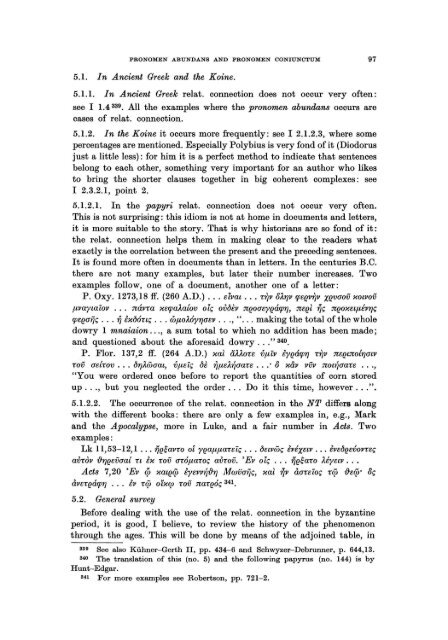Pronomen Abundans and Pronomen Coniunctum. A ... - DWC
Pronomen Abundans and Pronomen Coniunctum. A ... - DWC
Pronomen Abundans and Pronomen Coniunctum. A ... - DWC
Create successful ePaper yourself
Turn your PDF publications into a flip-book with our unique Google optimized e-Paper software.
PRONOMEN ABUNDANS AND PRONOMEN CONIUNCTUM 97<br />
5.1. In Ancient Greek <strong>and</strong> the Koine.<br />
5.1.1. In Ancient Greek relat. connection does not occur very of ten:<br />
see I 1.4 339 • All the examples where the pronomen abundans occurs are<br />
cases of relat. connection.<br />
5.1.2. In the Koine it occurs more frequently: see I 2.1.2.3, where some<br />
percentages are mentioned. Especially Polybius is very fond of it (Diodorus<br />
just a little less): for him it is a perfect method to indicate that sentences<br />
belong to each other, something very important for an author who likes<br />
to bring the shorter clauses together in big coherent complex es : see<br />
I 2.3.2.1, point 2.<br />
5.1.2.1. In the papyri relat. connection does not occur very of ten.<br />
This is not surprising: this idiom is not at home in documents <strong>and</strong> letters,<br />
it is more suitable to the story. That is why historians are so fond of it:<br />
the relat. connection helps them in making clear to the readers what<br />
exactly is the correlation between the present <strong>and</strong> the preceding sentences.<br />
It is found more of ten in documents than in letters. In the centuries B.C.<br />
there are not many examples, but later their number increases. Two<br />
examples follow, one of a document, another one of a letter:<br />
P. Oxy. 1273,18 ff. (260 A.D.) ... elVat ... T~V oÀ'YJv qJee~v xevaoiJ "OLVOiJ<br />
flvaytaiov . .. návTa "eqJaÀalov olç ovbÈv neoaeyeáqJ'YJ, neei ~ç neO"elflév'YJç<br />
qJeeaijç ... ~ è"CJóTtç ... WfloÀóY'YJaev ..., "... making the total of the whole<br />
dowry 1 mnaiaion ..., a sum total to which no addition has been made;<br />
<strong>and</strong> questioned about the aforesaid dowry ..." 340.<br />
P. Flor. 137,2 ff. (264 A.D.) "ai aÀÀoTe vfliv èyeáqJ'YJ T~V neemol1jatv<br />
ToiJ aet-rov ... b1jÀwaat, vfleîÇ bÈ ~fleÀfJaaTe ...· 8 "liv viJv not~aaTe ...,<br />
"You were ordered once before to report the quantities of corn stored<br />
up ..., but you neglected the order ... Do it this time, however ...".<br />
5.1.2.2. The occurrence of the relat. connection in the NT differs along<br />
with the different books: there are only a few examples in, e.g., Mark<br />
<strong>and</strong> the Apocalypse, more in Luke, <strong>and</strong> a fair number in Acts. Two<br />
examples:<br />
Lk 11,53-12,1 ... ije~avTo oE Yf}aflflaTeîç ... CJeLVWÇ ÈvéXeLV ... èvebeevovTeç<br />
aVTov {}'YJeevaal Tt è" ToiJ aTóflaToç aVToiJ. 'Ev olç ... ije~aTo UyelV ...<br />
Acts 7,20 'Ev cp "ateip lyevv~{}1j Mwvaijç, "ai ~v àaTeioç Tip {}eip' 8ç<br />
dveTf}áqJ1J ... lv Tip oi,,'!> ToiJ naTeÓç 341.<br />
5.2. General survey<br />
Before dealing with the use of the relat. connection in the byzantine<br />
petiod, it is good, I believe, to review the history of the phenomenon<br />
through the ages. This will be done by means of the adjoined tabie, in<br />
339 See also Kühner-Gerth 11, pp. 434-6 <strong>and</strong> Schwyzer-Debrunner, p. 644,13.<br />
340 The translation of this (no. 5) <strong>and</strong> the following papyrus (no. 144) is by<br />
Hunt-Edgar.<br />
341 For more examples see Robertson, pp. 721-2.
















